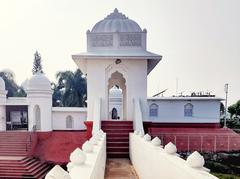Rupban Mura Visiting Hours, Tickets, and Historical Significance
Publication Date: 19/07/2024
Introduction to Rupban Mura
Rupban Mura, nestled in Cumilla Adarsha, Bangladesh, is an archaeological site that offers a window into the rich Buddhist heritage of ancient Bengal. Dating back to the 7th century, Rupban Mura is part of the renowned Mainamati-Lalmai range, a series of low hills housing numerous significant Buddhist remains. The site is particularly notable for its well-preserved ruins of a Buddhist monastery and stupa, which reveal the architectural and cultural influences of the Gupta and Pala periods. This ancient site has been a hub for religious and educational activities, drawing pilgrims and scholars from various regions. Whether you are a history enthusiast, a cultural explorer, or a curious traveler, Rupban Mura provides an immersive experience into the historical and spiritual fabric of Bangladesh. (Mainamati-Lalmai range)
Contents Overview
- Introduction
- Early Historical Context
- Archaeological Discoveries
- Architectural Significance
- Religious and Cultural Impact
- Preservation and Conservation Efforts
- Modern-Day Relevance
- Key Artifacts and Inscriptions
- Influence on Regional Architecture
- Visitor Information
- Visiting Hours
- Ticket Prices
- Guided Tours
- Travel Tips
- Accessibility
- Educational and Research Opportunities
- Visitor Experience
- FAQ
- Conclusion
Discover the Rich History and Visitor Information of Rupban Mura in Cumilla
Early Historical Context
Rupban Mura’s history spans from the 7th to the 12th centuries CE, during the reign of the Chandra and Deva dynasties. These dynasties played a crucial role in spreading Buddhism in the region, a fact evident in the architectural and cultural remnants at the site.
Archaeological Discoveries
Excavations in the early 20th century unveiled a treasure trove of artifacts and structures, including a Buddhist monastery and a stupa. The stupa, a dome-shaped structure, symbolizes the burial mound of relics, while the monastery complex features monk cells, a central courtyard, and a shrine room.
Architectural Significance
Rupban Mura’s architectural style showcases the influence of Gupta and Pala art, marked by intricate carvings and detailed sculptures. The use of terracotta plaques and stone carvings depicting Buddhist deities and motifs highlights the artistic prowess of the era.
Religious and Cultural Impact
The site was a pivotal center for Buddhist learning and practice in Bengal. The monastery and stupa attracted pilgrims and served as a hub for religious and educational activities. Artifacts and inscriptions found at Rupban Mura offer invaluable insights into the religious practices, social structure, and daily life of its inhabitants.
Preservation and Conservation Efforts
The Bangladesh Department of Archaeology has undertaken preservation efforts to protect Rupban Mura. Restoration work and a museum showcasing excavated artifacts aim to ensure the site’s longevity as a resource for historical research and tourism.
Modern-Day Relevance
Today, Rupban Mura attracts global visitors with its historical significance and architectural beauty. The site offers a glimpse into Bangladesh’s cultural heritage and serves as a testament to the region’s historical importance. Visitors can explore the ruins, view museum artifacts, and learn about the ancient Buddhist civilization.
Key Artifacts and Inscriptions
Key discoveries at Rupban Mura include terracotta plaques from the Jataka tales, illustrating the previous lives of the Buddha. These plaques and inscriptions in ancient scripts like Brahmi and Devanagari provide valuable information about Buddhist iconography, storytelling traditions, language, literature, and administrative practices.
Influence on Regional Architecture
Rupban Mura’s architectural style has influenced subsequent developments in the Bengal region. The use of terracotta and stone carvings, along with the design of the stupa and monastery, contributed to the evolution of Buddhist architecture in South Asia and later Hindu and Islamic styles.
Visitor Information
- Visiting Hours: Rupban Mura is open to visitors from 9 AM to 5 PM daily.
- Ticket Prices: Admission is free, but donations for site preservation are welcome.
- Guided Tours: Available upon request, offering detailed explanations of the site’s history and significance.
- Travel Tips: Wear comfortable shoes, carry water, and visit during the cooler months for the best experience.
- Accessibility: The site is accessible to visitors with disabilities, with clear pathways and informative signage.
Educational and Research Opportunities
Scholars and students from around the world visit Rupban Mura for its educational and research opportunities. The site offers a unique chance to study ancient Bengal’s art, religion, and history. Ongoing excavations and research continue to uncover new information about the region’s past.
Visitor Experience
Rupban Mura provides a rich and immersive experience for visitors. The well-maintained site features clear pathways and informative signage. The on-site museum displays a range of artifacts, including pottery, coins, and sculptures. Guided tours and the natural beauty of the surrounding area enhance the visitor experience.
FAQ
- What are the visiting hours for Rupban Mura? Rupban Mura is open from 9 AM to 5 PM daily.
- How much are tickets to Rupban Mura? Admission is free, but donations for site preservation are welcome.
- Is Rupban Mura accessible for visitors with disabilities? Yes, the site has clear pathways and informative signage for accessibility.
Conclusion
Rupban Mura is a site of immense historical and cultural significance, offering insights into the ancient Buddhist civilization of Bengal. Its well-preserved ruins, rich collection of artifacts, and ongoing research make it a must-visit destination for history and culture enthusiasts. With continued preservation efforts, Rupban Mura will remain a valuable resource for future generations, offering a deeper understanding of the region’s rich heritage. (Bangladesh Department of Archaeology)
Call to Action
Plan your visit to Rupban Mura today! Download our mobile app Audiala for more travel tips, check out related posts on our blog, and follow us on social media for updates on historical sites in Bangladesh.
